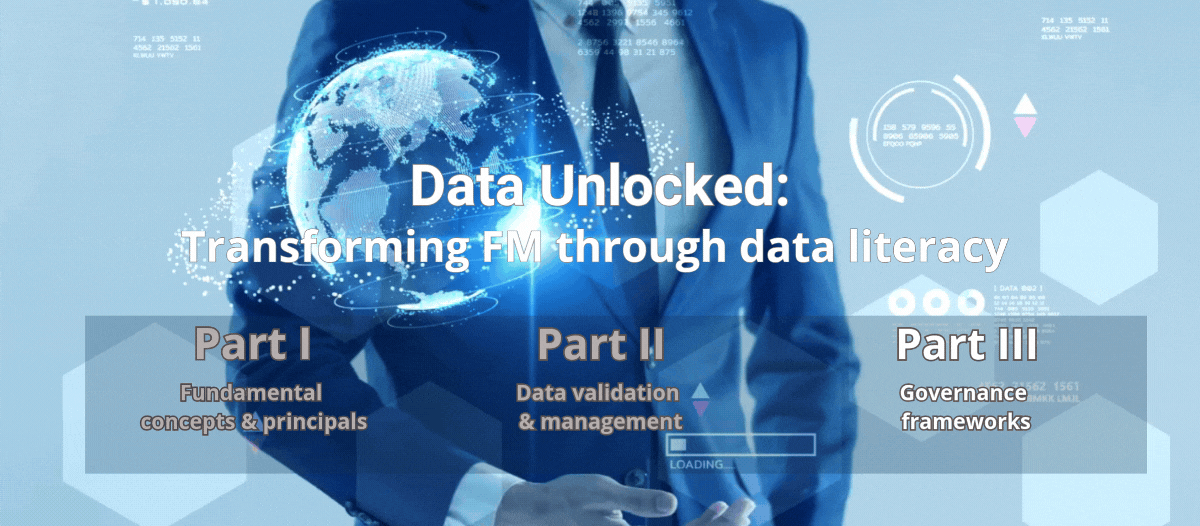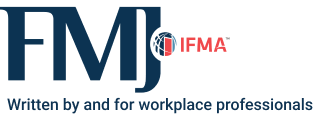Data Unlocked:
Part III: Governance frameworks

Editor’s note: This is the third article in a three-part series discussing the fundamental concepts of data literacy, validation and governance and FM.
Data governance is the leadership initiative that ensures data is not only accurate but also protected, compliant and effectively managed. FMs must understand the policies and standards that help streamline processes; use industry standards like BIM, Omniclass and UniFormat; and grasp the roles necessary to establish a robust data framework.
Data governance: A leadership-led initiative
Defining data governance for FM
Data governance is akin to managing a large commercial real estate portfolio: it needs oversight, consistent standards and defined roles to maintain efficiency. In the context of FM, data governance ensures that data across various sources — like building automation systems, maintenance records and utility usage — is consistent, secure and aligned with organizational goals.
Data governance is typically led by leadership teams, either at an executive or departmental level. It is not just a technical exercise; it is about establishing a culture in which data is treated as a valuable asset. Just as a CEO or facility director would steer a capital improvement project, the governance of data requires strategic oversight to align with long-term business goals.
Without a strong governance framework, data tends to fall into silos, become inconsistent and less useful for decision making. Imagine a property manager who receives conflicting maintenance schedules from different teams — that chaos, due to a lack of consistency and oversight, is what happens when data is poorly governed.
 Key components of a data governance framework
Key components of a data governance framework
Policies and rules: Just like building regulations dictate the design, safety standards and use of buildings, data governance policies define how data should be managed. These policies lay out the rules for data collection, maintenance, usage and disposal. For example, an organization may create rules regarding the frequency of maintenance data updates or how to ensure compliance with privacy laws.
Access control and security: Imagine managing access to a secure facility with different levels of authorization. Data access works similarly, only specific roles should have access to certain data types. Setting these boundaries is crucial for safeguarding sensitive information like tenant records or compliance data.
Data ownership and accountability: Effective data governance also requires clear ownership. Designating a "data owner" is similar to assigning an FM to a specific building: someone is always accountable for what happens to that data. Ownership ensures stewardship and clear accountability, which in turn drives reliability and consistency.
Developing & implementing data management policies
Establishing standards for data consistency
Standards are essential to achieving consistency across multiple data sets, much like ensuring uniform practices in construction projects. In data governance, integrating industry standards like building information modeling (BIM), Omniclass and UniFormat creates a cohesive framework for managing and sharing information effectively.
BIM serves as a central, digital repository that represents the physical and functional characteristics of a facility. By linking data such as maintenance schedules, asset information and life cycle costs, BIM enables all stakeholders — from architects to FMs — to access a unified source of truth. For example, FMs can use BIM to visualize an HVAC system within a 3D model and access related maintenance records seamlessly.
Omniclass provides a comprehensive classification system, incorporating construction and operational components, to categorize various elements of a built environment. For instance, it standardizes how assets like elevators, lighting systems or mechanical equipment are labeled and cataloged. This helps teams across departments or even separate organizations refer to the same classifications, reducing confusion during procurement, maintenance or project management processes.
UniFormat, on the other hand, organizes building information based on functional elements rather than specific products. An FM team might use UniFormat to group and analyze all data related to a building’s exterior envelope or mechanical systems. This functional organization simplifies the process of pinpointing maintenance needs or evaluating component life cycles.
By way of example, using BIM in conjunction with Omniclass and/or UniFormat, FMs create a robust ecosystem for data consistency. Together, these tools ensure that all stakeholders access standardized, accurate and actionable information, streamlining collaboration and enhancing decision making across all phases of a facility’s life cycle.
There are more standards than these. This is simply an illustration of how standards and classification systems can work together. Data governance is how FMs weave these standards and systems into a cohesive framework that supports the organization’s goals and objectives. There is no single dominant framework for all to follow. FMs should choose the standards and systems that best suit their needs and stick with them.
Creating effective data management procedures
Creating structured procedures for data management is akin to having a well-defined standard operating procedure (SOP) for maintenance. These procedures ensure that data is regularly audited, reviewed and updated.
Imagine a utility monitoring system that logs the daily energy consumption for each building in a commercial real estate portfolio. If these logs are not reviewed periodically for accuracy, the resulting inconsistencies could lead to incorrect utility bills, missed anomalies or compliance issues. Establishing regular data review procedures is much like scheduling preventive maintenance to avoid costly breakdowns: consistent data reviews help keep data healthy and reliable.
Similarly, data life cycle management involves determining when data is no longer useful for day-to-day operations but must be archived for reference or compliance purposes. For example, data on outdated lighting systems in a retrofitted facility may be archived to track historical consumption and to satisfy regulatory documentation requirements.
Defining roles: Data stewards, data custodians & data entry clerks
In a data governance framework, data stewards, data custodians and data entry clerks each play essential roles in maintaining a robust data ecosystem. These roles are interdependent, much like the coordination required among property managers, building engineers and administrative teams in facility management.
Data stewards are the property managers of the data world. They are responsible for ensuring data quality, consistency and compliance. For example, a steward might oversee maintenance schedules, ensuring that the data is accurate, up-to-date and shared with all relevant departments. They align the organization’s data practices with strategic objectives, serving as a bridge between technical teams and decision makers.
Data custodians are like building engineers who maintain the systems where data resides. Their responsibilities include ensuring the accuracy, completeness and timeliness of data in the system. For instance, a custodian validates that newly entered data adheres to established standards, ensures required fields are filled correctly, and conducts periodic reviews to identify and resolve discrepancies. They are also tasked with securing the database infrastructure, performing regular backups and maintaining system functionality to support efficient data access.
Data Entry serves as the front line in the data governance process. While the term “data entry clerk” is used in the data governance taxonomy, this role is intended for anyone who originates new data or updates existing data in a given system. The role of data entry is to input data into systems according to predefined standards and procedures. For example, when new equipment is procured, a data entry role ensures that details such as asset type, purchase date, warranty terms and maintenance schedules entered into the database are complete, accurate and timely. This foundational work ensures the reliability of the data pipeline and provides a solid basis for the roles of stewards and custodians. By following clear entry protocols and ensuring meticulous data capture, data entry play a critical role in supporting the overall data governance framework.
Training & upskilling personnel
To effectively establish data stewardship and custodianship roles, facility teams need access to proper training. Data management is increasingly becoming a vital part of FM, and teams must evolve accordingly. Upskilling in these areas is akin to providing building engineers with training on the latest HVAC systems. Resources like OSCRE and platforms such as Coursera can provide FM professionals with the expertise to effectively manage data governance roles.
Real-world applications of data governance in FM
Case study: Successful implementation of data governance
Consider the case of a large corporate campus that implemented data governance to enhance its asset management practices. By adopting standardized procedures for data entry and developing a clear framework for accountability, the organization saw significant improvements. They reduced asset downtime by 15 percent through more reliable maintenance scheduling and realized substantial cost savings by preventing overlapping service contracts. This case exemplifies the tangible benefits of a solid data governance framework.
Challenges & solutions
Data governance initiatives, while beneficial, do come with challenges. Data silos are a common issue in FM: when different teams store their data in isolated systems, it becomes difficult to get a holistic view of operations. One solution is to implement cross-functional data teams and use integration tools that aggregate data from various sources. Additionally, obtaining buy-in from stakeholders can be challenging, especially when changes impact established processes. Educating stakeholders on the benefits — such as improved efficiency and lower costs — can help mitigate resistance.
Building a data-driven culture in FM
Establishing governance guidelines & accountability
Building a data-driven culture begins with developing governance guidelines that lay out how data should be handled, shared and protected. Think of these guidelines as the operational manual that defines how a facility is managed, ensuring everything runs smoothly and reliably. Assigning accountability for data practices, much like assigning operational tasks to facility managers, helps set clear expectations and maintains discipline across teams.
Implementing data governance metrics
To evaluate whether data governance policies are working, metrics are essential. Metrics such as data quality scores, audit results and compliance rates can help FMs understand where improvements are needed. It is much like tracking the performance metrics for a building’s energy efficiency. If certain datasets are frequently incorrect or incomplete, it may indicate the need for additional training or procedural adjustments.

Tools & resources for data governance
 Identifying useful software & platforms
Identifying useful software & platforms
FMs can benefit from exploring data governance software tools specifically designed to manage CRE data. Useful search phrases include "data compliance tools for CRE data management" or "best data governance software for FM." These tools can streamline how data is governed, ensuring consistency and security throughout the data life cycle.
Learning & certification resources
FMs should also explore online learning resources. OSCRE offers industry-specific courses, while platforms like Coursera provide more general training options, such as the University of Virginia’s Data Governance Principles course. Engaging in these opportunities is similar to attending a certification workshop for energy management: focused training with real-world application.
Conclusion: Turning data governance into action
Data mastery begins by introducing fundamental concepts of data literacy, including key terminology and principles essential for understanding and managing data effectively. Becoming fluent in the "language of data" enables FMs to communicate across teams and make informed decisions based on accurate, relevant information.
FMs can build upon this foundation by addressing the critical need for data quality. Practical strategies, such as implementing data validation protocols and leveraging metadata for context, highlight the importance of treating data as a strategic asset capable of driving operational efficiencies and reducing risks.
Leadership-led governance initiatives creates the structure needed to ensure data consistency, security and compliance. Through the use of industry standards like BIM, Omniclass and UniFormat, FMs can demonstrate how consistent classification systems can streamline collaboration and improve data sharing across departments. The complementary roles of data stewards, custodians and entry are integral to maintaining data integrity and accessibility.
It is essential for FMs to recognize that these insights are not a substitute for working with skilled technology and data practitioners. Much like constructing a high-performing building requires architects, engineers and contractors, implementing an effective data governance framework demands collaboration with experts who can bring these concepts to life.
Understanding these principles is only the first step. To put them into action, FMs must take deliberate steps to integrate data governance and literacy into their operational practices. Here are a few practical next steps to begin this journey:
-
Establish a data governance committee
Assemble a cross-functional team that includes representatives from operations, IT, finance and leadership. This committee should be tasked with developing governance policies, defining data standards and assigning ownership for key datasets.
-
Conduct a data readiness assessment
Evaluate the current state of the organization’s data. Identify gaps in data quality, inconsistencies and areas where data management practices need improvement. Use the results to prioritize governance initiatives and allocate resources effectively.
-
Implement training programs
Build data literacy across the team by offering training in data governance, management tools, and standards like BIM, Omniclass and UniFormat. Equip FM staff with the skills they need to collect, manage and interpret data accurately.
-
Leverage technology for governance
Invest in software solutions that support data governance and management. Tools for metadata management, compliance tracking and data quality monitoring can streamline processes and ensure consistency across the organization.
-
Develop metrics to track progress
Establish key performance indicators (KPIs) for data governance efforts. Metrics like data accuracy, timeliness and access compliance can help measure success and identify areas for ongoing improvement.
By taking these steps, FMs can move beyond theoretical understanding to practical implementation, creating a robust framework that supports data-driven decision making, operational efficiency and strategic growth. The journey toward data mastery is ongoing, but the rewards — better insights, improved collaboration and enhanced value — are well worth the effort.
FMs stand at the threshold of a new era in which data-driven decision making can transform operations, improve tenant experiences and increase the strategic value of facilities. The journey ahead requires not only adopting the tools and frameworks, but also fostering a culture of continuous improvement and collaboration. By embracing data governance as an ongoing process, FMs can lead their organizations toward a future defined by efficiency, innovation and resilience.

References
ISO 8000 Data Quality - Standard for data quality management: iso.org/standard/50798.html
ISO 19650:2018 – Building Information Modeling (BIM): iso.org/standard/68078.html
Omniclass Construction Classification System - A classification system for construction data: omniclass.org/
OSCRE Data Governance Training - Industry standards and training resources for data governance: oscre.org
Coursera Data Governance Training - Data Governance Principles by University of Virginia: coursera.org/learn/data-governance
Technology Maturity: Skills and Progression
1drv.ms/b/s!AjQjNwCtaX1GovcRT2wNvibybCHY-Q?e=VFLG77
Read more on Technology and Emerging Topics
Explore All FMJ Topics










